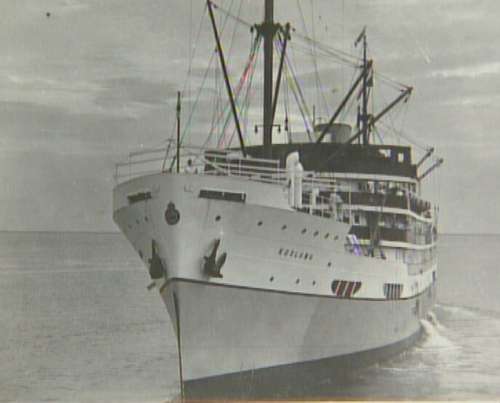- Author
- Wright, Ken
- Subjects
- Ship histories and stories, History - WW2
- Tags
-
- RAN Ships
- None noted.
- Publication
- March 2008 edition of the Naval Historical Review (all rights reserved)
For anyone fortunate enough to be holidaying in the top end of Western Australia and find themselves on the old section of the Wyndham pier, spare a thought for the Motor Vessel Koolama resting in the deep mud of the bay not far from where they are standing. The only hint of her location is the eerie swirling water over her grave.

The Koolama left Fremantle on Tuesday, 10 February 1942, bound for Darwin with a cargo of Army trucks and earthmoving equipment plus 180 passengers and crew and a small contingent of soldiers – a Second Lieutenant, a Sergeant, two Corporals and nine privates equipped with .303 rifles. The Koolama was a fairly new twin-screwed combined passenger and freight ship of 4000 tonnes, owned and operated by the Western Australian State Shipping Service on a coastal route between Fremantle and Darwin. She was equipped with a pair of Lewis machine guns and a 50 mm anti submarine cannon. When the ship reached Broome, the news of the fall of Singapore on February 15 to the Japanese forces was viewed with great apprehension.
En route to Wyndham a Japanese aircraft was spotted at about 11.30 am and the alarm bells rang. The Kawanishi 97 reconnaissance flying boat circled the ship and Captain Eggleston ordered all hands to Battle Stations and to open fire. He also began taking evasive action by twisting and turning his ship’s course. The pilot attacked from a height of about 800 metres and dropped four bombs, which missed the ship. Koolama’s distress call went unheeded in Darwin.
Unknown to everyone onboard Koolama, at 9.58 am the day before they were attacked, 188 aircraft from Admiral Nagumo’s First Air Fleet carriers Mitsuo, Soryu, Hiryu and Kaga in the Timor Sea and from the 21st Air Flotilla base at Kendari on the former Dutch island of Celebes struck two crippling blows against Darwin. Japanese attacks would continue sixty two more times, until November 1943.
Around 1.30 pm that same afternoon, three more float planes attacked the Koolama. Again the Captain began evasive manoeuvres and opened fire. The attack was over in thirty minutes and of the eighteen bombs dropped, only four hit near the stern. The damage was serious but not fatal. Number 4 hold was filling up with water. The bulkhead separating 3 and 4 holds was also damaged, allowing water to enter Number 3 hold and into the propeller shaft tunnel, the steering gear was out of action and two crew had been wounded.
Koolama was in danger of slowly sinking. By alternating the revolutions of the twin propellers, Captain Eggleston managed to steer the crippled ship towards the coast approximately 40 kilometres away. The ship entered Calamity Bay [now Koolama Bay] near Cape Rulhieres in the remote Kimberley region, one of the most inhospitable places on earth. Around 4.30 pm, Captain Eggleston gave the order to abandon ship except for a handful of volunteers who remained aboard to help beach the ship. Chief Officer Ken Reynolds supervised the remaining passengers, crew and military personnel to go ashore.
The next day a suitable spot with fresh water from a nearby waterfall was found and a more permanent camp was established.
The Chief Officer returned to the Koolama, reported to the Captain about the situation onshore and began transferring medical, food and other essential supplies to the camp. The military set up watches in case the Japanese attempted a landing.
On Saturday 21 February at 11.30 am, a single aircraft was spotted. The lone Kawanishi bomber slowly descended towards the disabled ship and gave it a good burst of machinegun fire then gained height, circled and dropped three bombs which missed, then left. The volunteer crew began work trying to repair the ship but they worked at night as it was too hot during the day. Meanwhile the shore party continued to ferry supplies to their camp about four kilometres from the beached ship.
Unknown to the stranded survivors, their second mayday call had been heard in Darwin and on 22 February, authorities sent a coded message to the closest community that was in a position to offer help. The Kalumburu Catholic Mission, established in the mid 1930s, received the message and the Superior, Father Thomas Gill, replied they would send a small sailing boat for the survivors. The following day, Father Seraphim Sanz and a crew of seven aboriginals set sail in the early morning for the area where the ship was reported to be. Also that day, two aboriginals set out on a hazardous overland trek through the inhospitable country to try and contact the survivors and deliver a letter that help was on the way.




